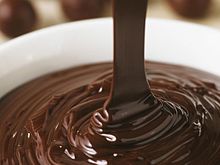ganache
Jump to navigation
Jump to search
See also: Ganache
English
[edit]

Etymology
[edit]Borrowed from French ganache, from Italian ganascia (“jaw”), ultimately from Ancient Greek γνάθος (gnáthos) (see gnatho-).
Pronunciation
[edit]Noun
[edit]ganache (countable and uncountable, plural ganaches)
- A rich sauce, made of chocolate and cream, used also as the filling of truffles, and as a glaze.
- 2006, Dede Wilson, Truffles: 50 Deliciously Decadent Homemade Chocolate Treats, Harvard Common Press, →ISBN, page 11:
- The centers of truffles are typically a ganache, which is most often simply a mixture of chocolate and cream. The recipes will direct you to chop the chocolate finely—do not overlook this step!
- 2016 June 27, Tejal Rao, “Making Mochi, a Japanese Treat That’s All About Texture”, in The New York Times[1], →ISSN:
- She scoops a grassy, barely sweet green-tea sorbet onto white chocolate ganache, and garnishes it with coin-size meringues that break easily, then strings syrupy, candied yuzu zest across it all.
- (historical) A kind of surcoat with short cap sleeves.
- Synonym: garnache
- 1819, James Robinson Planche, A Cyclopedia Of Costume Vol. II A General History Of Costume In Europe, page 85:
- M. Viollet-le-Duc says the ganache, which he considers a beautiful and simple garment, disappeared at the end of the fourteenth century. M. Quicherat makes brief mention of it as a surcoat without sleeves or girdle , and neither ...
- (Can we date this quote?), The Medieval Wedding Planner, Lyle MacPherson
- Male clothing was worn in layers of a tunic, cote, or cotte with a surcoat over a linen shirt. […] a long sleeveless tunic. When sleeves (and sometimes a hood) were added, the cyclas became a ganache (a cap-sleeved surcoat, usually shown with hood of matching color) or a gardcorps (a long, generous-sleeved travelling robe).
- 2001, John Steane, The Archaeology of Power: England and Northern Europe, AD 800-1600, Tempus Pub Limited
- Illuminated miniatures show them in long robes of plain or rayed material, hoods and coifs. […] shows a man 6ft in length dressed in a ganache or tabard with two tongues or labels at the neck and a coif tied round his head.
- 2020, Paul Doherty, The House of Shadows, Canelo, →ISBN:
- Cranston plucked at the ganache, the over-robe Bohun wore, tied round the middle with a ribbon. 'You've lost weight?' 'Bellum intestinum,' Bohun whispered, picking up the tankard. 'War within! There's something wrong with my gut, ...
Translations
[edit]Translations
|
Further reading
[edit] ganache on Wikipedia.Wikipedia
ganache on Wikipedia.Wikipedia  Category:ganache on Wikimedia Commons.Wikimedia Commons
Category:ganache on Wikimedia Commons.Wikimedia Commons
French
[edit]Etymology
[edit]Borrowed from Italian ganascia (“jaw”).
Pronunciation
[edit]Noun
[edit]ganache f (plural ganaches)
- (anatomy) jawbone
- (figuratively, informal) face
- (figuratively, informal) fool, numskull
- (cooking) ganache (sauce made of chocolate and cream)
Further reading
[edit] ganache on the French Wikipedia.Wikipedia fr
ganache on the French Wikipedia.Wikipedia fr- “ganache”, in Trésor de la langue française informatisé [Digitized Treasury of the French Language], 2012.
Anagrams
[edit]Spanish
[edit]Noun
[edit]ganache f (plural ganaches)
Categories:
- English terms borrowed from French
- English terms derived from French
- English terms derived from Italian
- English terms derived from Ancient Greek
- English 2-syllable words
- English terms with IPA pronunciation
- English terms with audio links
- Rhymes:English/æʃ
- Rhymes:English/æʃ/2 syllables
- Rhymes:English/ɑːʃ
- English lemmas
- English nouns
- English uncountable nouns
- English countable nouns
- English terms with quotations
- English terms with historical senses
- en:Clothing
- en:Chocolate
- French terms borrowed from Italian
- French terms derived from Italian
- French 2-syllable words
- French terms with IPA pronunciation
- French terms with audio links
- French lemmas
- French nouns
- French countable nouns
- French feminine nouns
- fr:Anatomy
- French informal terms
- fr:Cooking
- Spanish lemmas
- Spanish nouns
- Spanish countable nouns
- Spanish feminine nouns